Imagine you're a veteran NFL quarterback. You're on top of your game, making every throw with ease and scoring at will, dominating opponents with your elite combination of experience and a still-advanced skill set -- and then it happens. Suddenly, you can't connect with your receivers as quickly or as accurately as you once did; your completion percentage plummets and your sacks and interceptions skyrocket. Seemingly overnight, your once-powerful game has escaped you. You've hit the quarterback wall.
Of course, it's hard to predict exactly when a specific player will hit that wall, as it often arises without warning, but the impact tends to be shockingly swift; the moment looms for all players in the later stages of their career.
Schein: The never-ending discussion

Yup, the great quarterback debate is back! Adam Schein establishes who is "elite" -- and how we should view the other QBs. **READ**
Two of the best quarterbacks in the game today -- Peyton Manning and Tom Brady -- are also two of the oldest. That Manning and Brady are still top-notch contenders is consistent with the way that quarterbacks have, in general, been hitting the wall later than ever. When I was with the Dallas Cowboys in the early 1960s, we knew quarterbacks tended to hit the wall at around age 31. Since then, the wall has been pushed back to about 34 or so (a benchmark that Manning and Brady have obviously surpassed). This trend came about for a number of reasons, not the least of which is the fact that quarterbacks are simply in better shape, thanks to year-round workout programs. Guys no longer gain (and subsequently have to lose) 30 pounds every offseason. Better diets and workout regimens have led to increased longevity.
That said, there is still a wall, and time does take its toll on players. Manning and Brady might not have hit the wall yet, but they will eventually, as all quarterbacks must. In the meantime, a young, talented crop of signal-callers has risen in the past few years, headed by phenoms like Andrew Luck and Colin Kaepernick -- and Russell Wilson, who helped the Seahawks beat Manning and the Broncos in Super Bowl XLVIII despite being a much less experienced quarterback. Speaking of Super Bowls, the NFL's showcase game hasn't been kind to older quarterbacks in recent years; the last quarterback aged 33 or older to win a Super Bowl was Brad Johnson, who, at 34, helped the Bucs to victory in Super Bowl XXXVII back in 2003.
So I thought I'd split the current quarterback group into two generations -- "grizzled veterans" and "rising stars" -- in an effort to see whether there's a changing of the guard underway at the position. Are Manning and Co. still the top dogs, or are Wilson and his fellow upstarts about to unseat the older crew? Below, you'll find the top five quarterbacks in both categories -- for the purpose of this piece, "grizzled veterans" are starting quarterbacks who will be 33 or older when the 2014 season starts, and "rising stars" are those who will be 26 or younger -- along with an explanation as to why I think the younger generation will have more success, as a group, in 2014.
GRIZZLED VETERANS
1) Peyton Manning, Denver Broncos, 37 years old
Manning, who will turn 38 in March, is coming off the best regular season ever by a quarterback, certainly better than what would've seemed likely at his age; he played out of his mind, setting new statistical high-water marks and stamping his name in the history books with a record fifth MVP award. But don't forget that the wall can pop up almost without warning. Think of the baseball pitcher who wins the Cy Young one season and is out of MLB by the end of the next. I'd say Manning can keep winning for about two more years, provided he wants to play that long, but it's tough to know if he'll hit the wall sooner than that.
2) Tom Brady, New England Patriots, 36
Brady, who still brings velocity to his throws and makes quick decisions, continues to play the position better than anyone -- except, of course, Manning. Though he'll turn 37 in August, he is, like Manning, outstanding. That said, he's also on the downside of his career, with his stats predictably in decline. Over the past three seasons, his completion percentage has dropped five points (from 65.6 to 60.5), while his yardage total fell (from 5,235 in 2011 to 4,343 in 2013), as did his touchdown total (39 to 25). Yes, the subpar receiving corps he had to work with in 2013 impacted that somewhat, but that's not the only factor; for example, in the AFC title game, he missed some throws on the outside that he would have made three years ago. As with Manning, it's tough to predict exactly when Brady will hit the wall, but I'd give him another two years of viability.
3) Drew Brees, New Orleans Saints, 35
Brees hasn't slowed down much. He can still throw it deep very easily and has excellent accuracy. His Saints struggled in 2012, but then, we shouldn't forget that he was without coach Sean Payton that season. In 2013, Brees' completion percentage improved, while his yardage and touchdown totals remained more or less steady. He did take 11 more sacks (from 26 to 37), but that likely had something to do with the absence of left tackle Jermon Bushrod, who took off for the Bears via free agency. Brees continues to have velocity and a nice, quick release. Brees still slots in behind Manning and Brady for now, but while I see Brady and Manning starting to slip in the coming years, I don't think Brees will falter, unless tight end Jimmy Graham (eligible to become a free agent this offseason) winds up leaving the team.
'ATL Podcast'

The Around The League team hits all the NFL's hottest topics in its award-winning podcast. Join the conversation. **Listen**
4) Tony Romo, Dallas Cowboys, 33
Romo is a tough nut to crack, what with the back injury and surgery that prematurely ended his 2013 season. If, as recent reports indicate, his health won't be an issue in 2014, Romo should continue to play at a high level for the Cowboys for the next three years or so. While he has been in the NFL for 11 years, he was a backup for the first three, meaning he's really only played eight -- so the mileage on him is not nearly as severe as that on some of his contemporaries. Romo, who will turn 34 in April, is competitive, with a quick release and above-average arm strength. Of course, it's not like he's going to get better, but I think he'll be fine for a while.
5) Eli Manning, New York Giants, 33
The 2013 season was a very disappointing one for Manning, who completed less than 50 percent of his passes in three different games and was sacked an astounding 39 times -- including seven times in a loss to the Panthers. That said, I don't think he's hit the wall just yet. Manning didn't have much of a running game to speak of, nor did the Giants have a tight end on the roster who really suited their system. The offensive line was decimated by injuries, while the receiving corps struggled. Furthermore, he had to deal with the swirling winds of MetLife Stadium, which I think is among the most challenging places to play in the NFL. I didn't see any kind of decline in Manning's physical ability or velocity; provided New York finds someone to block for him, I think he'll rebound and perform at a high level for another three seasons or so.
RISING STARS
1) Andrew Luck, Indianapolis Colts, 24
Luck is off the charts, really. In 2013, he accomplished the virtually impossible by shepherding a Colts squad that won just two games in 2011 to its second consecutive 11-win season, bucking the historical trend that says such teams should take a sizable step back after making a big leap like that. He also cut down on his interceptions and sacks while boosting his passer rating by 10 points. Just two years into his career, he's already pretty darn good -- but the thing is, he'll get even better. If anyone in this group of youngsters has a chance to put together a career that will rival Peyton Manning's one day, it's Luck.
2) Cam Newton, Carolina Panthers, 24
Though his statistical output has been more or less level through his first three years in the league, Newton, who will turn 25 in May, has become a better quarterback, specifically with regard to passing. Where he once threw the ball hard and fast, he now can take some speed off his throws when necessary; he also seems to have better downfield touch. He doesn't have much of a supporting cast on offense, yet helped the Panthers finish 12-4 after a 1-3 start. He's about one year away from reaching his prime.
3) Matthew Stafford, Detroit Lions, 26
Like the rest of the Detroit Lions, Stafford had a definite down year in 2013. That said, he did do some things right, like cutting down on his sacks -- and, for what it's worth, former coach Jim Schwartzrecently spoke out in support of the quarterback, saying the team's troubles couldn't be put solely on Stafford's shoulders. Ultimately, I think Stafford will come back strong and perhaps reach his prime in 2014. I think new coach Jim Caldwell will do a good job with him; Caldwell's background, after all, is in offense.
4) Colin Kaepernick, San Francisco 49ers, 26
You could see Kaepernick grow in his first full season as the Niners' starting quarterback, especially with regard to decision-making. In 2012, he was more prone to take off and run if his first read wasn't there; in 2013, he was much better overall at deciding when to run and when to pass. He still has room to improve, of course, as we saw in the NFC title game, in which he not only turned the ball over three times, but he also incurred a costly delay-of-game penalty in the fourth quarter. I think he's about two years away from truly fulfilling his potential.
5) Russell Wilson, Seattle Seahawks, 25
Wilson is a lot like Brees, another relatively short-statured quarterback, especially in the way that he knows exactly where and when to throw the football. This is a key part of one of the most impressive things about him: He does not let his passes get blocked, despite his height. Wilson did have a puzzling failure to connect at times, recording a completion percentage below 50 in three different games. That said, he's already won the sport's ultimate prize -- and he's just about to enter his third season. He's still just scratching the surface of what he can do.
Conclusion
While Peyton Manning and Brady might still rank above most of the younger quarterbacks on this list, I think the edge ultimately goes to the rising stars, if only by a hair. The bottom line is, while most of the younger guys still have room to improve, I think all five will show this season they've ascended to the point where they're capable of taking a team to the Super Bowl, and I'm not sure you could say the same about each of the five grizzled veterans. And while the older crew includes Manning and Brady, the youngsters are led by Luck, who is pretty good, too.
Follow Gil Brandt on Twitter _@GilBrandt_.












